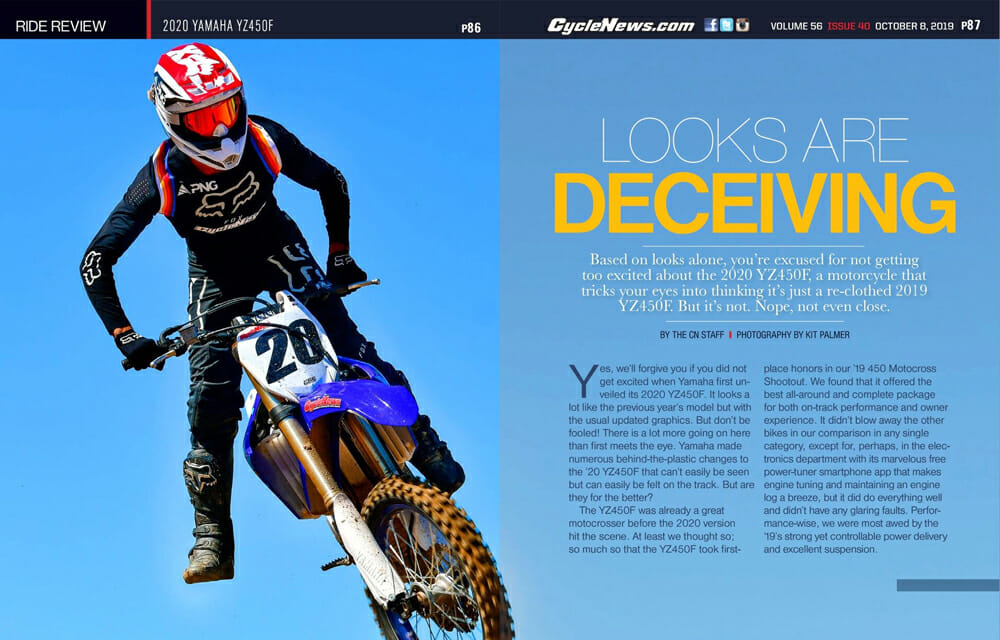Cycle News Staff | October 13, 2019
Based on looks alone, you’re excused for not getting too excited about the 2020 YZ450F, a motorcycle that tricks your eyes into thinking it’s just a re-clothed 2019 YZ450F. But it’s not. Nope, not even close.
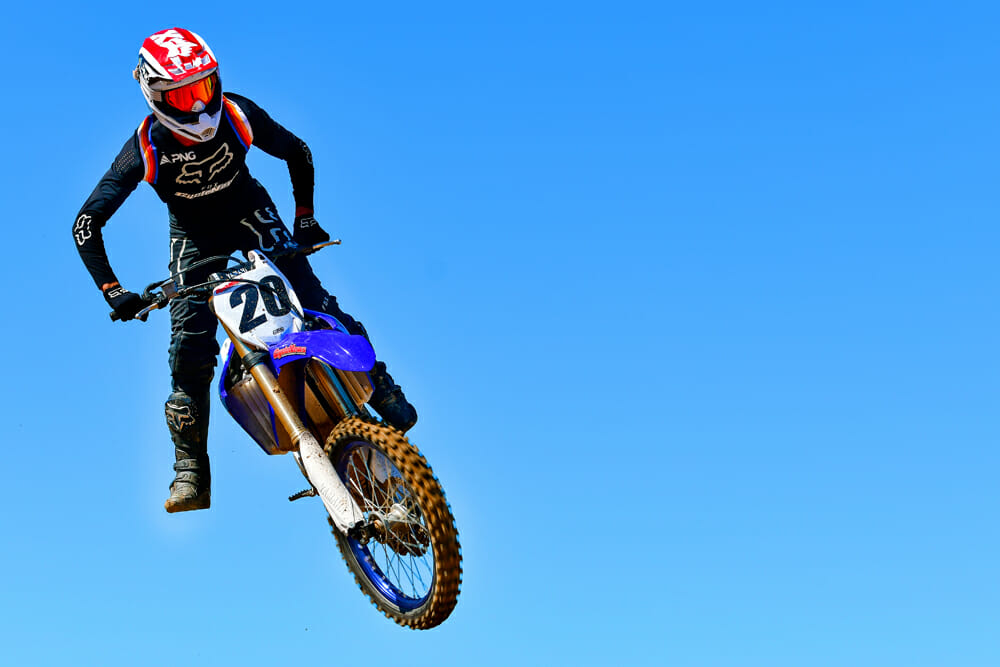
Photography by Kit Palmer
Yes, we’ll forgive you if you did not get excited when Yamaha first unveiled its 2020 YZ450F. It looks a lot like the previous year’s model but with the usual updated graphics. But don’t be fooled! There is a lot more going on here than first meets the eye. Yamaha made numerous behind-the-plastic changes to the ’20 YZ450F that can’t easily be seen but can easily be felt on the track. But are they for the better?
The YZ450F was already a great motocrosser before the 2020 version hit the scene. At least we thought so; so much so that the YZ450F took first-place honors in our ’19 450 Motocross Shootout. We found that it offered the best all-around and complete package for both on-track performance and owner experience. It didn’t blow away the other bikes in our comparison in any single category, except for, perhaps, in the electronics department with its marvelous free power-tuner smartphone app that makes engine tuning and maintaining an engine log a breeze, but it did do everything well and didn’t have any glaring faults. Performance-wise, we were most awed by the ’19’s strong yet controllable power delivery and excellent suspension.
As good as the ’19 was, however, Yamaha, a company never known to sit back and rest on its laurels and give the other manufactures a chance to catch up, continued with its development of the YZ450F. So here we are.
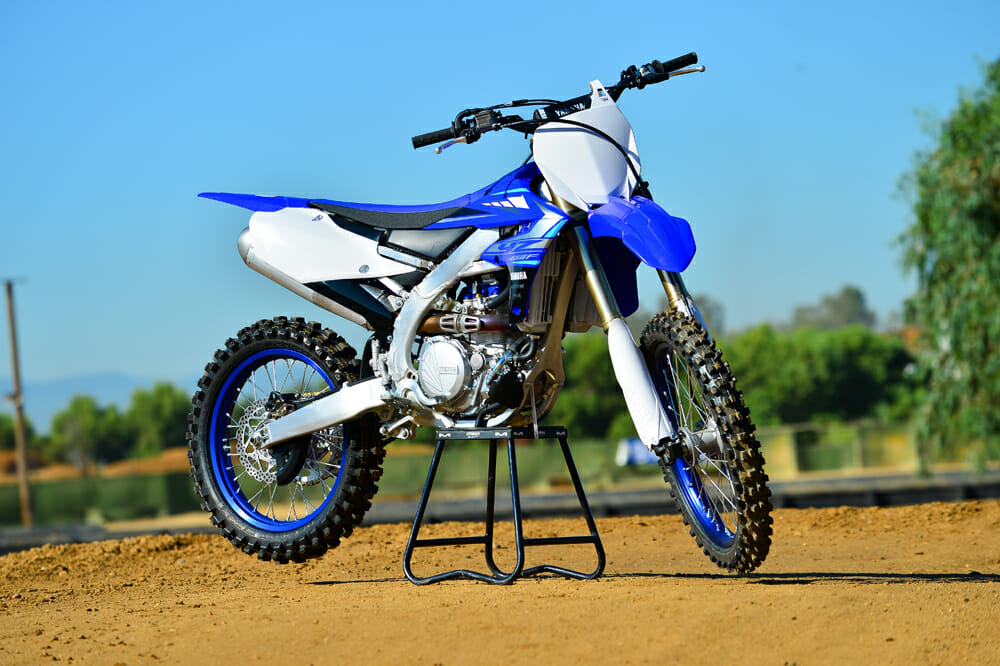 Please, give everyone in Yamaha’s style department a standing ovation.
Please, give everyone in Yamaha’s style department a standing ovation.
For 2020, Yamaha made many not-so-obvious changes to the engine, chassis, and suspension. When it comes to the YZ’s 449cc liquid-cooled DOHC engine, more specifically its power delivery, Yamaha felt there was room for improvement. So they dove into the top-end and redesigned the head, making it smaller, shorter, and more compact. It’s lighter, as well. These mods, Yamaha says, also changes the way the YZ handles—for the better, of course—because these changes also lower the bike’s overall center of gravity. Keep in mind that, in this case, you’re also lowering all those moving parts inside the head that can make a bike feel heavy and sluggish when spinning ferociously, so we’re talking more than just merely lowering static weight.
The shapes of both the intake and exhaust ports are revised, as well, and the compression ratio bumped up from 12.8:1 to 13.0:1. You can thank a new high-compression piston and a smaller combustion chamber for that.
The new head also features steeper valve angles for an even straighter downdraft intake power port. Cam profiles are also more aggressive.
Also, the connecting rod has been lengthened 1.5mm to reduce side loads on the piston.
Delving deeper into the engine, you’ll find a new condenser, a now one-piece rectifier/regulator, a tweaked air filter with improved sealing, and an updated exhaust pipe with a larger-diameter head pipe.
The ECU mapping has been re-calibrated, and there is now, like the YZ250F debuted last year, a two-position map switch on the handlebar that allows you to make changes mid-moto without having to pull over. Yamaha has also updated its smartphone power-tuner app.
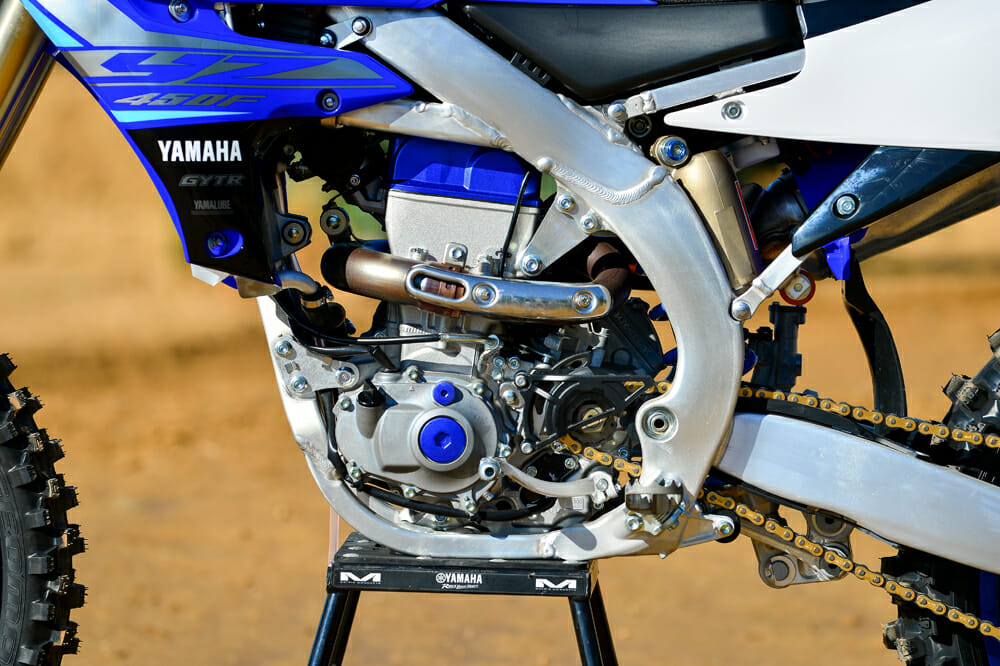 A new cylinder head improves both engine and handling performances.
A new cylinder head improves both engine and handling performances.
In the five-speed gearbox, the gear drive dog heights are slightly taller for increased durability and more accurate shifts.
In the chassis department, Yamaha went through the YZ’s bilateral beam aluminum frame with a fine-tooth comb in search of that perfect blend of flex and rigidity to give the rider the best possible feel, comfort, and control on the track. They tried many combinations and finally settled on one where the thickness of the mainframe spar is reduced by a scant 0.5mm, and the lower cradle tube thickness is increased by the same amount, 0.5mm. Yamaha said they also added more flex to the top triple clamp area and reduced the front axle diameter by 1.4mm for a claimed 20 percent reduction in rigidity. And that’s not all; the top engine mount is now steel instead of aluminum, and the lower engine mount is now aluminum instead of steel.
Handlebars are positioned 5mm lower and mounted slightly farther forward (away from the rider). The rubber-mounted handlebar mount can still be positioned four ways, front to back. Yamaha even updated the footpegs; they’re now made out of chrome-moly steel and reshaped at the bottom for improved ground clearance.
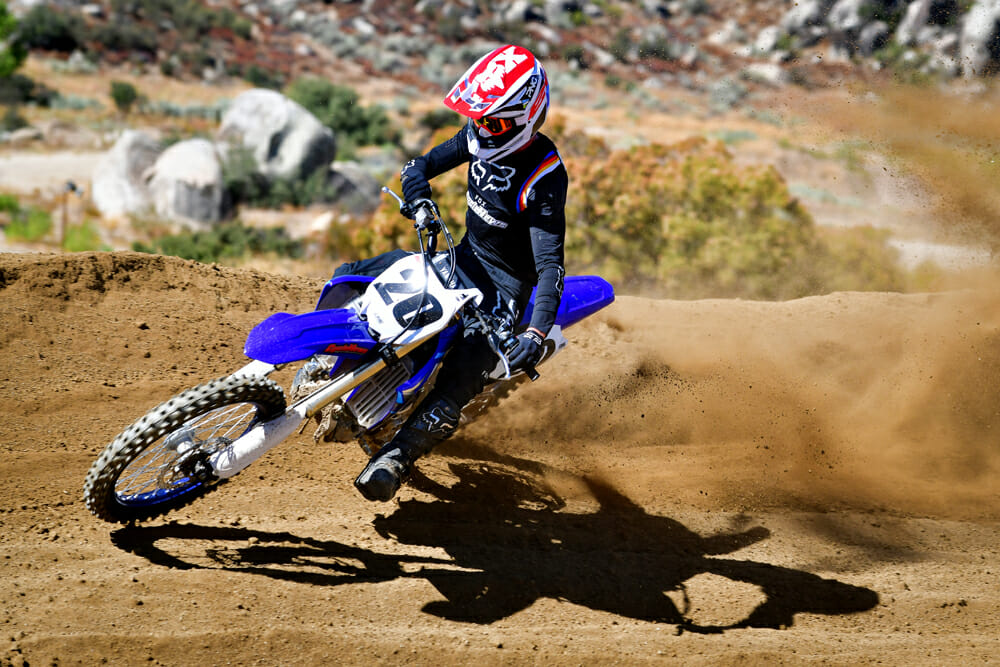 The YZ450F has come a long way for the better when it comes to turning.
The YZ450F has come a long way for the better when it comes to turning.
Our only real complaint with last year’s bike was the overly soft (and thin) seat padding, which allowed your butt to get too intimate with the upper frame rails. Padding is 10% firmer now.
The Dunlop Geomax MX3S tires have been swapped out in favor of Dunlop’s well-liked soft/intermediate-terrain MX33s.
Brakes got an overhaul, too. The front features a new caliper with larger pistons with 16% more surface area between the pads and rotor. Yamaha discovered that going to a larger rear disc on the previous model caused more harm (heat issues and risk of damage) than good, so it went back to a 5mm smaller, 240mm diameter rotor. Yamaha says a new rear caliper hanger is a quarter-pound lighter. Overall, Yamaha claims the ’20 YZ450F is about a pound lighter than the 2019 model. With a full tank of fuel, our test bike weighed in at 248 pounds, which is indeed a pound lighter than our 2019 test bike.
Yamaha updated the suspension settings of the KYB SSS fork and KYB shock to complement all of the chassis updates. Both the fork and shock have firmer compression and damping settings while valving mods were made to maintain compliance over the smaller bumps.
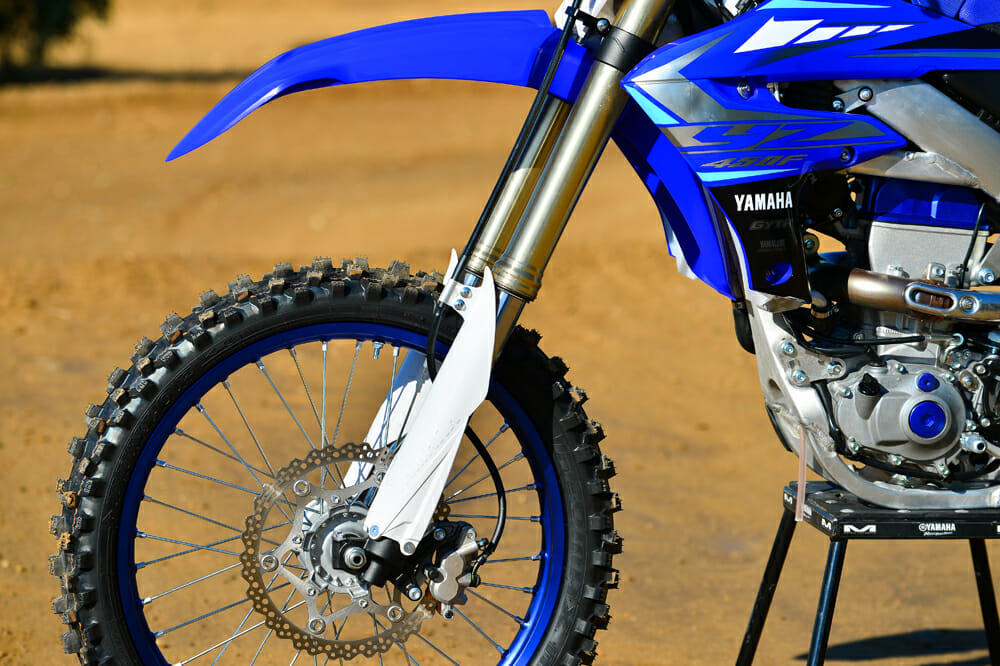 The YZ’s KYB SSS fork is still a great performer, and the updated front brake offers plenty of power and excellent feedback.
The YZ’s KYB SSS fork is still a great performer, and the updated front brake offers plenty of power and excellent feedback.
2020 Yamaha YZ450F Lap Time
We spent our first day on the 2020 YZ450F comparing it back-to-back with the 2019 YZ450F and quickly discovered that these two bikes feel surprisingly different. At first, our Pro-level test rider was a little disappointed with the power of the ’20, saying it felt a little underpowered and didn’t have the bark he liked of the ’19, but, just like the looks of the ’20 YZ450F, the ’20’s power is deceiving, too. The more he rode the ’20 YZ450F, the more he realized that this bike wasn’t “slow” by any means but instead way more controllable and manageable. It delivered all of its power more smoothly and deliberately than the ’19, which also meant that it put the power to the ground better and efficiently. As a result, the bike initially felt mellower and tamer which gave him that false feeling of it being slow, when in fact, the 2020 YZ450F is still just as fast and powerful as the ’19. However, the power is delivered in a more user-friendly way while still feeling somewhat aggressive. The more we rode the ’20 YZ450F, the more we liked its engine.
Another thing that our testers could feel right away was weight. The 2020 YZ450F feels significantly lighter than the ’19 YZ450F even though the ’20 weighs, as mentioned, just one pound less than last year’s, but it feels a lot more than that on the track. Lowering the cylinder head combined with all those frame tweaks and motor-mount changes do make a difference as to how the bike feels on the track, pretty much all for the better.
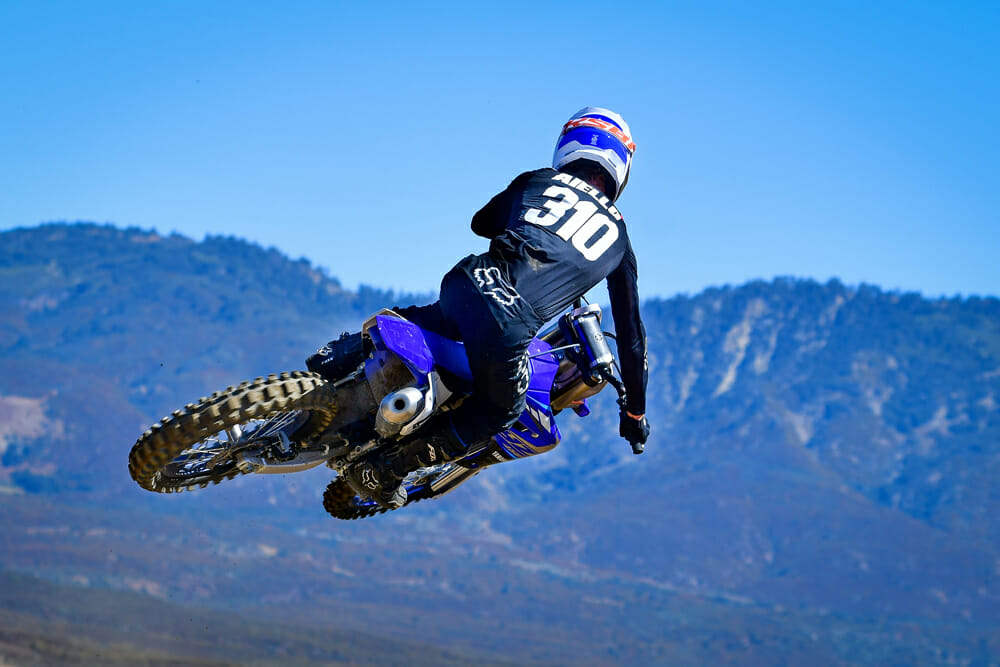 The YZ450F might not be the lightest bike in its class, but it sure feels like it is when on the track.
The YZ450F might not be the lightest bike in its class, but it sure feels like it is when on the track.
The 2020 YZ450F has a slight rigid feeling at first, but that can be, if you want, eliminated by playing a little bit with clicker adjustments on the suspension, both front and rear. Our 170-pound pro tester, however, felt that the ’20’s suspension was set up pretty well for him right out of the crate, although he did stiffen things up just a bit. (But he always tends to do that to suit his ultra-aggressive riding style.)
The Yamaha’s light feeling, however, is somewhat negated by its still wide feeling between your knees, which was a concern of our pro tester. He’s always been a little annoyed by this with previous YZ450Fs, however, he’s always managed to deal with it just fine.
The 2020 YZ450F continues to do many things well, too. It’s an excellent-handling motorcycle with great suspension that tackles a wide variety of terrain and obstacles well. The bike feels agile and has come a long way over the years in the turning department. It’s a lot better overall, but some still feel a little at odds with it, saying the front end sometimes lacks feel and confidence. Our pro rider isn’t one of them, however. He feels the YZ turns well on hard-packed flat surfaces as well as in the ruts and loamy berms.
The Yamaha has excellent brakes; they are powerful and compliant. Clutch also has a good feel and resists fading. And the handlebars have plenty of adjustment.
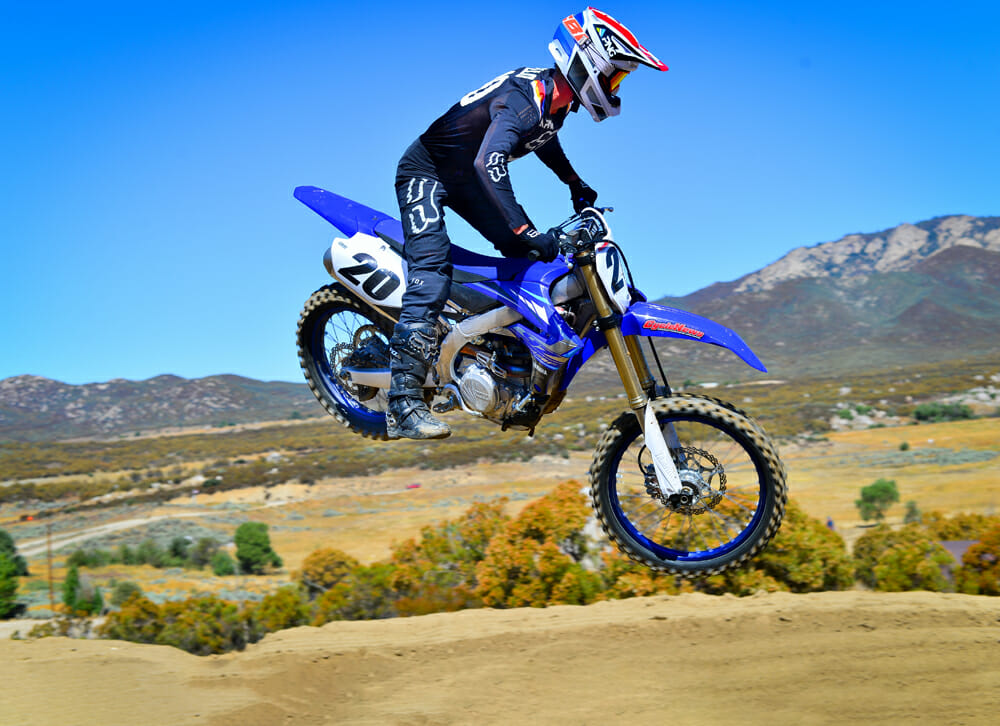 The YZ450F gets high marks in agility.
The YZ450F gets high marks in agility.
One of our favorite things about the YZ450F is the power-tuner app. It’s free, easy to use, and handy for tailoring exactly how you want the YZ’s power to be delivered from your throttle hand. We were surprised to hear Yamaha reps say not as many YZ owners are taking advantage of the app as Yamaha thought they would. They’re guessing owners are intimidated by it or are worried they might harm the engine, but Yamaha says that’s impossible. Hey, if we haven’t yet blown up a YZ engine using the app, then you won’t either. So download the free app and give it a try. To get it, click HERE (How cool is that?)
We’ve only just begun testing the 2020 Yamaha YZ450F, but we’re plenty happy with it so far. Power is just as strong but more user-friendly than before, and it’s one of the lightest-feeling bikes on the track with one of the best suspensions. Throw in the free power-tuner app, and you have a bike that is hard to resist.CN
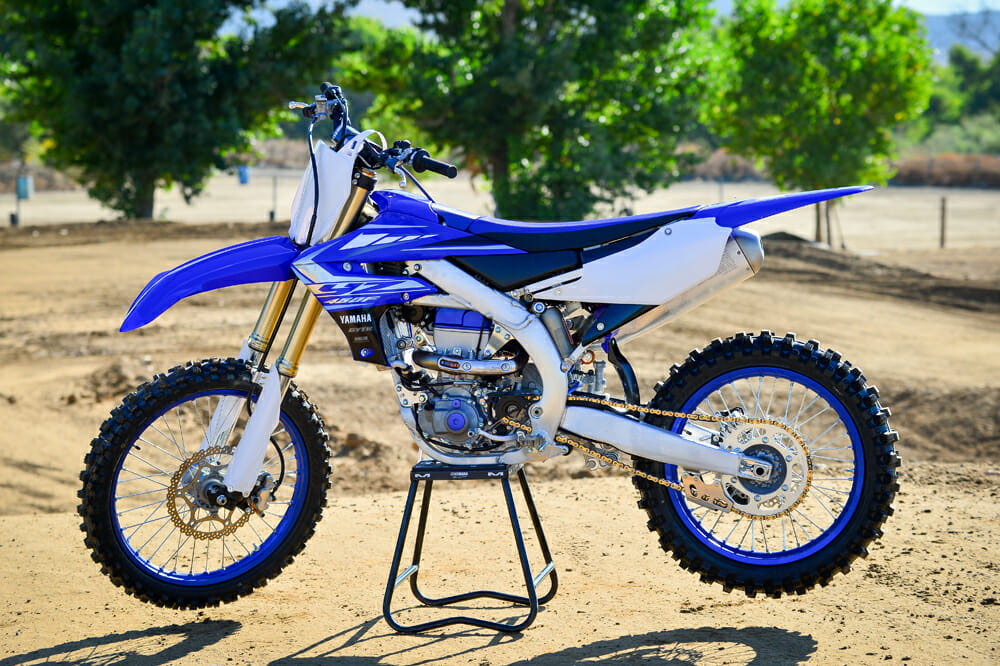
2020 Yamaha YZ450F Specifications
| MSRP: |
$9,399 |
| Engine: |
Liquid-cooled, DOHC, 4-stroke, single |
| Displacement: |
449cc |
| Bore x stroke: |
97.0mm x 60.9mm |
| Compression ratio: |
13.0:1 |
| Fuel delivery: |
Mikuni fuel injection, 44mm |
| Transmission: |
5-speed; multiplate wet clutch |
| Final drive: |
Chain |
| Frame: |
Bilateral beam, aluminum |
| Front suspension: |
KYB Speed Sensitive System (SSS), coil-spring, fully adjustable |
| Rear suspension: |
KYB single shock fully adjustable |
| Front-wheel travel: |
12.2 in. |
| Rear-wheel travel: |
12.5 in. |
| Front brake: |
Nissin, single 270mm disc, 2-piston caliper |
| Rear brake: |
Nissin, single 240mm disc, 1-piston caliper |
| Front tire: |
80/100-21 in. Dunlop MX33 |
| Rear tire: |
120/80-Dunlop MX33 |
| Seat height: |
38.0 in. |
| Wheelbase: |
58.3 in. |
| Rake: |
27.0° |
| Trail: |
4.7 in. |
| Ground clearance: |
13.0 in. |
| Fuel capacity: |
1.6 gal. |
| Weight (claimed, wet): |
245 lbs. |
